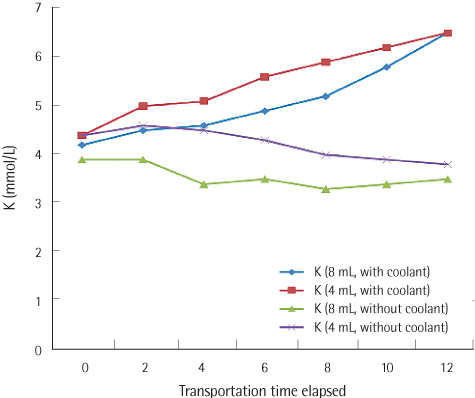Lab Med Online.
2011 Apr;1(2):72-80. 10.3343/lmo.2011.1.2.2.
Effects of Long Distance Transportation of Specimens on Test Results
- Affiliations
-
- 1Department of Laboratory Medicine, Kwandong University College of Medicine, Goyang, Korea. capt95@kd.ac.kr
- 2Laboratory Medicine and Genetics, Soonchunhyang University Bucheon Hospital and Soonchunhyang University College of Medicine, Bucheon, Korea.
- 3Department of Laboratory Medicine, University of Ulsan College of Medicine and Asan Medical Center, Seoul, Korea.
- KMID: 1446272
- DOI: http://doi.org/10.3343/lmo.2011.1.2.2
Abstract
- BACKGROUND
Accuracy of laboratory test results is an important issue. New guidelines for specimen delivery systems are needed for appropriate pretreatment of specimens and accuracy of results.
METHODS
We evaluated various laboratory profiles, comparing the effects of specimen rack holders and coolants within transport containers. The hematology profiles (complete blood cell count [CBC], erythrocyte sedimentation rate [ESR]), chemistry profiles (aspartate aminotransaminase [AST], alanine aminotransaminase [ALT], gamma-glutamyl transferase [gamma-GT], electrolytes [Na, K, Cl], glucose, lactate dehydrogenase [LD], creatinine kinase [CK]), and coagulation profiles (prothrombin time [PT], activated partial thromboplastin time [aPTT], fibrinogen level). We also investigated the effects of transportation time including the presence or absence of hemolyzation. We received from 9 different university hospital laboratories using conventional transporation methods.
RESULTS
Hemolytic features were seen in short drawn specimens. Fewer result variations were observed in specimens transported with coolants. Average specimen transportation time was 11.3 hours, and average temperatures of container was 10.9degrees C with coolant and 25.0degrees C without coolants. Non-centrifuged specimens transported with coolants showed increased serum K levels than centrifuged specimens. Coagulation tests showed less than a 10% differences. Centrifuged specimen prior to transportation showed no hemolyzation and no differences in results.
CONCLUSIONS
Appropriate temperatures for each analyte should be defined to ensure the accuracy of results. To reduce hemolyzation, appropriate temperature and rack holder should be used. Temperature of the transport container should be monitored in objectively. Coagulation tests should be added as referral tests, if appropriate specimen transport monitoring system for time and temperature could be adopted.
Keyword
MeSH Terms
-
Alanine
Blood Cell Count
Blood Sedimentation
Creatinine
Dietary Sucrose
Electrolytes
Fibrinogen
Glucose
Hematology
Hemolysis
L-Lactate Dehydrogenase
Laboratories, Hospital
Partial Thromboplastin Time
Phosphotransferases
Referral and Consultation
Transferases
Transportation
Alanine
Creatinine
Dietary Sucrose
Electrolytes
Fibrinogen
Glucose
L-Lactate Dehydrogenase
Phosphotransferases
Transferases
Figure
Cited by 1 articles
-
Validation of Temperature Preservation in Specimen Transportation Systems
Sang Gon Lee, Aerin Kwon, Seungman Park, Soyeon Seo, Young Jin Kim, Hyoeun Shim, Chorong Ham, Jae-Seok Kim
Lab Med Online. 2020;10(2):116-124. doi: 10.3343/lmo.2020.10.2.116.
Reference
-
1. Berg B, Estborn B, Tryding N. Stability of serum and blood constituents during mail transport. Scand J Clin Lab Invest. 1981. 41:425–430.
Article2. Jensen EA, Stahl M, Brandslund I, Grinsted P. Stability of heparin blood samples during transport based on defined pre-analytical quality goals. Clin Chem Lab Med. 2008. 46:225–234.
Article3. Sinclair D, Briston P, Young R, Pepin N. Seasonal pseudohyperkalaemia. J Clin Pathol. 2003. 56:385–388.
Article4. Lewis SM, Bain BJ, editors. Practical haematology. 2001. 9th ed. Philadelphia: Churchill Livingstone.5. Plebani M. Errors in clinical laboratories or errors in laboratory medicine? Clin Chem Lab Med. 2006. 44:750–759.
Article6. Stroobants AK, Goldschmidt HM, Plebani M. Error budget calculations in laboratory medicine: linking the concepts of biological variations and allowable medical errors. Clin Chim Acta. 2003. 333:169–176.
Article7. Lippi G, Guidi GC, Mattituzzi C, Plebani M. Preanalytical variability: the dark side of the moon in laboratory testing. Clin Chem Lab Med. 2006. 44:358–365.
Article8. Seamark D, Backhouse S, Barber P, Hichens J, Salzmann M, Powell R. Transport and temperature effects on measurement of serum and plasma potassium. J R Soc Med. 1999. 92:339–341.
Article9. Clinical and Laboratory Standards Institute. CLSI document H21-A4. Collection, transport, and processing of blood specimens for testing plasma-based coagulation assays; approved guideline. 2003. 4th ed. Wayne, PA: Clinical and Laboratory Standards Institute.10. Weissman M. Evaluation of glucose determinations in untreated serum samples. Clin Chem. 1958. 4:420–422.
Article
- Full Text Links
- Actions
-
Cited
- CITED
-
- Close
- Share
- Similar articles
-
- Air Travel and Transportation of Patients (I) A guide for physicians
- Air Travel and Transportation of Patients (III): A guide for physicians
- Air Travel and Transportation of Patients (IV): A guide for physicians
- Validation of Temperature Preservation in Specimen Transportation Systems
- Comparative Evaluation of Emergency Medical Service Trauma Patient Transportation Patterns Before and After Level 1 Regional Trauma Center Establishment: A Retrospective Single-Center Study


